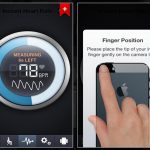 Early wearable devices were capable of detecting whether the wearer was experiencing a cardiac arrest, but more recent iterations have attempted to go one step further and predict when attacks may occur, with some even claiming to do so one month in advance.
Early wearable devices were capable of detecting whether the wearer was experiencing a cardiac arrest, but more recent iterations have attempted to go one step further and predict when attacks may occur, with some even claiming to do so one month in advance.
The latest innovation in this space comes via a collaboration between the UK and US-based Arrhythmia Alliance, Happitech in the Netherlands, and Bug Labs in the US. They’ve launched a new app, called Heart for Heart, that aims to monitor the health of our heart. Users place their fingers on the camera lens of their smartphone, and hold it there for 90 seconds to allow the app to take a pulse reading.
This data will be used by researchers to try and find a cure for Atrial Fibrillation, also known as AFib, the most common heart rhythm disorder.
Smart sensing
The technology behind the app is based upon PhotoPlethysmoGraphy (PPG). This allows the app to measure the light that is reflected in the blood. It’s known that blood absorbs light, with each pulse changing the flow of blood through the body, thus enabling us to measure heart rate from the changes in light absorption.
It’s a similar method to that used by pulse oximeters, and indeed many of the fitness trackers already on the market. It aims to track the variance between a regular and irregular heartbeat, with the data anonymized and used for research by medical professionals. The app will track the age, location, gender, weight, conditions and lifestyle of users in addition to their heart data to enable targeted research to be undertaken.
Big data and AI
A Stanford project led by Andrew Ng is utilizing machine learning to identify heart arrhythmias from an electrocardiogram (ECG). The team trained their algorithm to spot irregular heartbeats in ECG data. They worked closely with iRhythm, a company that makes portable ECG devices, to collect 30,000 30-second clips from patients who have various forms of arrhythmia.
The algorithm was pitted against a collection of cardiologists on 300 as then undiagnosed clips, with the algorithm performing very well.
It’s part of a growing body of work being undertaken to bring lifestyle data to medical research. Perhaps the most well known is the Baseline Project launched earlier this year by Google’s life science arm Verily.
It will see 10,000 people participate in a multi-year study into finding predictors for heart disease and cancer. Participants will subject themselves to extensive monitoring and testing via Google’s study watch, which will record their activity levels in real-time. In addition to the readings from the watch, participants will also undergo x-rays and heart scans, and will also have their genome mapped and blood tested at regular intervals over a four year period.
“No one has done this kind of deep dive on so many individuals. This depth has never been attempted,” the team say. “It’s to enable generations to come to mine it, to ask questions, without presupposing what the questions are.”
It’s clear that there is tremendous potential for user-generated data to contribute to medical research, and these are some nice examples from the front lines of this movement.